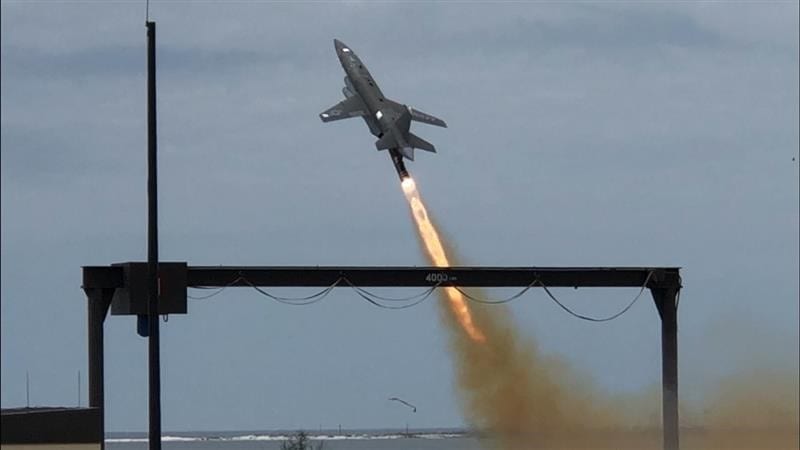
The Skyborg autonomy core system launches aboard a Kratos UTAP-22 tactical unmanned vehicle at Tyndall AFB, Florida on April 29. (U.S. Air Force)
The Air Force Research Laboratory (AFRL) conducted a first flight test on Apr. 29th of what is to be the collaboration and autonomy-enabling “brain” of Skyborg—the autonomy core system (ACS)—aboard a Kratos UTAP-22 Mako drone, AFRL said on May 5th.
The flight from Tyndall AFB, Fla. lasted two hours and 10 minutes during which the ACS “performed a series of foundational behaviors necessary to characterize safe system operation,” AFRL said in a statement. “The ACS demonstrated basic aviation capabilities and responded to navigational commands, while reacting to geo-fences, adhering to aircraft flight envelopes, and demonstrating coordinated maneuvering. It was monitored from both airborne and ground command and control stations.”
The flight test was Milestone 1 of the U.S. Air Force Autonomous Aircraft Experimentation effort.
Skyborg is one of three Air Force Vanguard programs to accelerate the fielding of advanced technologies. The Skyborg Program Executive Officer (PEO) is Air Force Brig. Gen. Dale White, who also serves as the PEO for Fighters and Advanced Aircraft, while the AFRL commander, Air Force Brig. Gen. Heather Pringle, serves as the Skyborg Technology Executive Officer. The 96th Test Wing, headed by Air Force Brig. Gen. Scott Cain, serves as the executing agent for the Skyborg test missions.
In a statement White said that he is encouraged by the May 5th “successful flight of an early version of the ‘brain’ of the Skyborg system.”
“It is the first step in a marathon of progressive growth for Skyborg technology,” he said. “These initial flights kickoff the experimentation campaign that will continue to mature the ACS and build trust in the system.”

Skyborg will provide the foundation on which the Air Force can build an airborne autonomous ‘best of breed’ system of systems that adapts, orients, and decides at machine speed for a wide variety of increasingly complex mission sets. (U.S. Air Force)
Beyond the meeting of Milestone 1, other tests of ACS are planned in the coming months, including the demonstration of manned-unmanned teaming and multiple ACS-controlled drones.
Pringle said on May 5th that AFRL wants “to get early engagement with the warfighter to deliver a suite of full-mission autonomy on a relevant timeline.”
Kratos said that the UTAP-22 Mako, introduced in 2015, has helped evolve drone technology through its participation in technology demonstrations and military exercises.
Steve Fendley, the president of Kratos’ Unmanned Systems division, said in a statement that the UTAP-22 “has served as an ideal technology incubator for missionization of the [Kratos] XQ-58A Valkyrie.”
The Apr. 29th ACS test follows the sixth flight test on March 26th of the Valkyrie drone at Yuma Proving Ground, Ariz.–a demonstration that featured the launching of an Area-I ALTIUS-600 small unmanned aircraft system (SUAS) from the Valkyrie’s internal weapons bay in what AFRL said was the first opening of the Valkyrie’s weapons bay.
AFRL said that Kratos, Area-I and AFRL designed and fabricated the SUAS carriage and developed software to enable the release of the ALTIUS-600.
Marietta, Ga.-based SUAS maker Area-I, recently acquired by Anduril Industries, has made strides in gaining U.S. Army acceptance in that service’s Project Convergence effort
Last December, the Air Force awarded more than $76 million to Kratos, Boeing, and General Atomics to build prototypes for the service’s Skyborg Vanguard program and fly them in teaming with manned aircraft.
The Air Force has said that it expects to begin experimentation with the Skyborg prototypes in July.
Skyborg is to develop a family of attritable aircraft systems with a common artificial intelligence (AI) backbone that can train alongside manned aircraft and eventually help complete tasks, fly ahead of Air Force pilots in non-permissive environments, and frustrate adversaries.
AFRL has used Kratos’ XQ-58A Valkyrie as an example of what a Skyborg prototype could look like.
In a Skyborg test last Dec. 9 at Yuma, a Valkyrie flew in formation with a Lockheed Martin F-22 and an F-35 fighter and served as a gatewayONE communications translator between the two fighters.
Northrop Grumman builds gatewayONE, which is to link fourth and fifth generation fighters and attritables as part of the Air Force Advanced Battle Management System.
The rocket-assisted takeoff of the Valkyrie shook the aircraft and prevented the establishment of the communication gateway, but the F-22, F-35, and Valkyrie were able to share information over a ground backup system, Air Force officials said.
The Air Force is eyeing an initial operational capability for Skyborg in 2023.